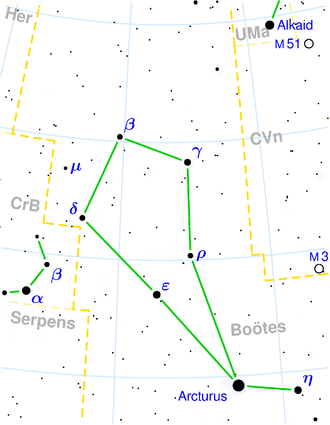NGC 5700
| Galaxie NGC 5700 | |
|---|---|
 | |
| SDSS-Aufnahme | |
| AladinLite | |
| Sternbild | Bärenhüter |
| Position Äquinoktium: J2000.0, Epoche: J2000.0 | |
| Rektaszension | 14h 37m 01,5s[1] |
| Deklination | +48° 32′ 41″[1] |
| Erscheinungsbild | |
| Morphologischer Typ | SBbc[1][2] |
| Helligkeit (visuell) | 14,4 mag[2] |
| Helligkeit (B-Band) | 15,2 mag[2] |
| Winkelausdehnung | 1,0′ × 0,4′[2] |
| Positionswinkel | 38°[2] |
| Flächenhelligkeit | 13,3 mag/arcmin²[2] |
| Physikalische Daten | |
| Rotverschiebung | 0.007202 ±0.000037[1] |
| Radialgeschwindigkeit | 2159 ±11 km/s[1] |
| Hubbledistanz vrad / H0 | (102 ± 7) · 106 Lj (31,2 ± 2,2) Mpc [1] |
| Geschichte | |
| Entdeckung | Lawrence Parsons |
| Entdeckungsdatum | 4. Mai 1877 |
| Katalogbezeichnungen | |
| NGC 5700 • UGC 9423 • PGC 52237 • CGCG 248-013 • MCG +08-27-07 • IRAS F14352+4845 • KUG 1435+487 • 2MASX J14370164+4832422 • | |
NGC 5700 ist eine 14,4 mag helle Balkenspiralgalaxie vom Hubble-Typ SBbc im Sternbild Bärenhüter. Sie ist schätzungsweise 102 Millionen Lichtjahre von der Milchstraße entfernt und hat einen Durchmesser von etwa 30.000 Lj.
Das Objekt wurde am 4. Mai 1877 von Lawrence Parsons entdeckt.[3]
Weblinks
- NGC 5700. SIMBAD, abgerufen am 14. April 2016 (englisch).
- NGC 5700. DSO Browser, abgerufen am 14. April 2016 (englisch).
- Auke Slotegraaf: NGC 5700. Deep Sky Observer's Companion, abgerufen am 14. April 2016 (englisch).
Einzelnachweise
Auf dieser Seite verwendete Medien
Autor/Urheber: Sloan Digital Sky Survey, Lizenz: CC BY 4.0
The sky image is obtained by Sloan Digital Sky Survey, DR14 with SciServer.
Angle of view: 4' × 4' (0.3" per pixel), north is up.
Details on the image processing pipeline: https://www.sdss.org/dr14/imaging/jpg-images-on-skyserver/



